


|

Irasema Venezia |
Irasema Venezia: "Child of the Sea" BalladChild of the seaInspiration of the mountains Child of the sun Who wouldn't leave you for a minute I want see your transparent, turquoise waters The day I enter paradise Child of the sea Who has stolen all the stars Your heart is of a romantic bohemian Who listens to the music of your palms To be forever bewitched Puerto Escondido, Oaxacan child Who feeds from the waters of the rivers Of this magical land where you were born To be the nest of the princes of love Child of the sea Your waves are starting to rise They want to fly until they reach infinity Desperate from their journey, they re finally arriving To embrace your bed of sand Puerto Escondido, your fisherman are returning Finding their way with the moonlight The Virgin of Solitude is always with you My spoiled sailor with flesh of salt |
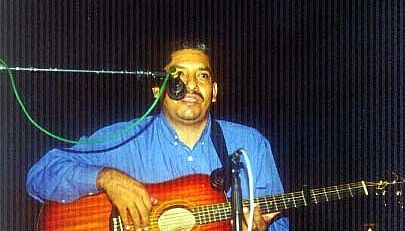
|

|
| Second place winner: Alberto Marroquín Juárez | Juventino Robles Pinacho sings his romantic bolero which took 3rd place in El Sol's "Song for Puerto" Contest |
Letter from Sr. Editor: I hope my readers will forgive me if this issue of El Sol de la Costa reaches your hands a little later than usual. June marked the third anniversary of the birth of this humble publication. And I decided to mark that milestone as I did last year's anniversary, when the Song for Puerto Contest was born.
The second edition of the contest was gratifying for the enthusiasm it generated in the community, the strength of the musical and poetic creativity it brought together and the participation and support of so many fine people. More evidence, as if any were needed, of the magical allure of Puerto Escondido and the affection that it inspires. But it was also a great deal of work to pull it all together and, I must confess, the preparations for this issue were temporarily neglected.
(See results of the 2nd Annual Song for Puerto Contest)
I did take a brief respite from my temporary assignment as Events Manager to get a preview of what awaits visitors at the new eco-attraction at Barra de Navidad. It was a thrilling and fulfilling experience that soothed my frayed nerves. The close proximity of Barra (It's only about fifteen minutes away from the center of Puerto) and the intimate view of a rich eco-system that can be found there make it a must-do trip for visitors. With the onset of the seasonal rains, this is a particularly rewarding time to observe the the natural world. The birds are nesting at the lagoons and the turtles are arriving in greater numbers on the beaches to lay their eggs (not to mention the crocodiles!). Barra de Navidad is wonderful for this purpose. For more, check here.
- - Warren Sharpe
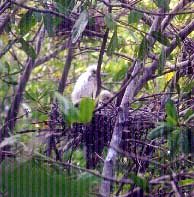 BARRA DE NAVIDAD, Even Closer to
Nature
The beauty and the amazing biodiversity of the Oaxacan coast has made this place a destination for
growing numbers of "eco-tourists." Not content to spend all their vacation time on the beach, these
visitors seek adventure, they want to get close to nature, enjoy unspoiled scenery and observe
wildlife in its natural environment. Clearly this is a sensible model for further tourist
development here, since it guarantees the preservation of these valuable resources.
BARRA DE NAVIDAD, Even Closer to
Nature
The beauty and the amazing biodiversity of the Oaxacan coast has made this place a destination for
growing numbers of "eco-tourists." Not content to spend all their vacation time on the beach, these
visitors seek adventure, they want to get close to nature, enjoy unspoiled scenery and observe
wildlife in its natural environment. Clearly this is a sensible model for further tourist
development here, since it guarantees the preservation of these valuable resources.
Now there is another stop on what, we have come to think of as the "Eco-Trail." The residents of neighboring Barra de Navidad have formed a non-profit organization to protect the nearby twin lagoons called Los Naranjos and Palmazola and offer short tours. It's one those win-win situations: good for the environment and for the economy of this poor village.
 The restored lagoons are teeming with birds and animal life. The mangrove lagoon-ocean environment
is typical of the geography of the Oaxacan coast. Rivers running down from the Sierras fill the
lagoons and run out to sea in the rainy season. In dry months, sand bars isolate the fresh water
lagoons from the ocean. These wetlands provide habitat for migratory and native birds, a wealth of
land and water reptiles, fish and mammals.
The restored lagoons are teeming with birds and animal life. The mangrove lagoon-ocean environment
is typical of the geography of the Oaxacan coast. Rivers running down from the Sierras fill the
lagoons and run out to sea in the rainy season. In dry months, sand bars isolate the fresh water
lagoons from the ocean. These wetlands provide habitat for migratory and native birds, a wealth of
land and water reptiles, fish and mammals.
Tours of the Barra de Navidad lagoons are a work in progress. The project awaits one final approval from the various governmental agencies and at this writing the community organization were still working out details on how to structure the tours. I arrived in the early evening and was met in the center of the village by two young biology students from the Politechnic University in Mexico D.F. They and their colleagues have been camping here, spending part of their vacation advising the villagers and moving the project forward. (The "Poly" has been involved with the Barra lagoons from project conception, as have some nonprofit conservation groups and governmental agencies, such as the Mexican Turtle Center, which supervised the release of 20 baby crocodiles into the environment last month to publicize this new attraction.)
We stopped first at the nearby iguana and crocodile hatchery to pick up Galo Sánchez, who oversees this operation and would serve as our guide. We all piled into my green baja-bug (affectionately known locally as the "guacamole-mobile") and made our way down the dirt road and through the horse corrals that leads to the lagoons. It's a short distance, perhaps a 20-minute walk; eventually the village hopes to offer horse rides to the lagoon.
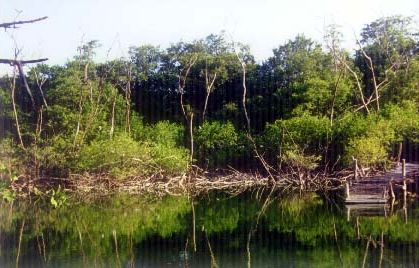 At a small clearing in the mangroves, we carefully boarded the small launch and Galo pole punted us
through the still waters. The evening was filled with a cacophonous chorus of bird song, ranging
from the shrieks of the gulls to the basso profundo of the cormorants. Literally hundreds of birds
were wheeling through the skies and flitting from tree to tree in their fussy preparations for
nightfall: herons, ibis, pelicans, huilila (anhinga anhinga) and the small nocturnal heron known
locally as the water dog for its barking cry. Although we didn't spot one of the rare spoon-bill
herons (ajoia ajaja) which inhabit the area.
At a small clearing in the mangroves, we carefully boarded the small launch and Galo pole punted us
through the still waters. The evening was filled with a cacophonous chorus of bird song, ranging
from the shrieks of the gulls to the basso profundo of the cormorants. Literally hundreds of birds
were wheeling through the skies and flitting from tree to tree in their fussy preparations for
nightfall: herons, ibis, pelicans, huilila (anhinga anhinga) and the small nocturnal heron known
locally as the water dog for its barking cry. Although we didn't spot one of the rare spoon-bill
herons (ajoia ajaja) which inhabit the area.
 Galo pointed out the soleras, spots along the shore where the crocodiles like to warm themselves in
the afternoon sun. We disembarked at a ricketty pier that leads to the short path to the beach.
Just above our heads, close enough to touch (but please don't), the intertwining branches held
dozens of ibis and cormorant nests, some with eggs. others containing chicks in various stages of
development. The sight literally took my breath away! On the beach itself, the villagers have
built an observation tower to view marine turtles as they laboriously haul themselves over the beach
and methodically carve out a hollow in the sand to deposit their eggs.
Galo pointed out the soleras, spots along the shore where the crocodiles like to warm themselves in
the afternoon sun. We disembarked at a ricketty pier that leads to the short path to the beach.
Just above our heads, close enough to touch (but please don't), the intertwining branches held
dozens of ibis and cormorant nests, some with eggs. others containing chicks in various stages of
development. The sight literally took my breath away! On the beach itself, the villagers have
built an observation tower to view marine turtles as they laboriously haul themselves over the beach
and methodically carve out a hollow in the sand to deposit their eggs.
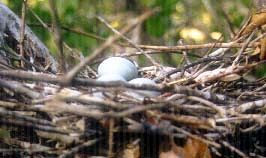 You should plan your visit for early evening or early morning to observe maximum animal activity.
(Only mad dogs and tourists go in the noonday sun.) Unaccompanied tours are not permited, because
of the ecological sensitivity of the area.
You should plan your visit for early evening or early morning to observe maximum animal activity.
(Only mad dogs and tourists go in the noonday sun.) Unaccompanied tours are not permited, because
of the ecological sensitivity of the area.
Barra de Navidad is the 'second' Barra, across the Colotepec River bridge on the coast highway towards Pochutla. Take the recently paved road into the center of town. If you are not approached by one of the villagers to help you, ask at José Luis's tienda across from the basketball court.
Holidays, Events & Notable
Days
Wed 4
U.S. Independance Day
Hot dogs at Art & Harry's. Rockets and other fireworks are always freely available at many of
the tiendas in the commercial center of town, should you wish to celebrate.
Thu 5
Full Moon in Capricorn at 10:05 p.m.
Fri 6
School's Out
Schools close for summer vacation throughout México. Good news for local merchants because it
hopefully portends the arrival of lots of visitors to revive the local economy that has been
languishing through the traditionally slow month of June.
Wed 11
9th Anniversary of Stereo Esmeralda
Our local FM station (94.1FM) celebrates its birthday today. Party plans were unavailable at
presstime
Sat 14
Bastille Day
The yanks had their day, now the French community celebrate their country's revolution.
Sat 14 - Mon 16
Fiesta of Our Lady of Carmen
This saint's day is very important in the city of Oaxaca, where it represents one of the roots
of the famous Guelaguetza. Here on the coast, Nuestra Señora de Carmen
is patron saint of Puerto's colonia Libertad and of Candelaria, Pochutla and the village of
Zapotalillo at Chacahua National Park.
Traditional saint's festivals on the coast include Calendas, lively processions through the streets with brass bands, huge papier-mache puppets and lighted candles inviting participation in the festivities. There are fireworks displays and jaripeos (bull riding rodeo competitions) and dances with live bands.
Wed 18
Anniversary of the Death of Benito Juárez
One of the colossal figures of Mexican history, Juárez died on this day in 1872. An illiterate
Zapotec Indian from Oaxaca who rose to become his nation's president, he is noted for his integrity,
patriotism and commitment to social justice. Flags are flown at half-mast on all public buildings.
Fri 20
New Moon in Cancer at 2:45 p.m.
Sat 21 - Mon 23
Fiesta of Mary Magdalane
This is the feast day of the patron saint of Santa Maria Magdalena Tiltepec, close to Santos
Reyes Nopala. This small village in the coffee-growing hill country is best known for the
slow-fired pottery produced by the ladies of the village using techniques virtually unchanged in
2,000 years.
The Nopala area, the traditional ceremonial center of the Chatino Indian culture, is always a fascinating region to visit.
Tue 24 - Thu 26
Fiesta of Saint James
Also in the Nopala area, the communities of Santiago Cuixtla and San Juan Lachao Pueblo Nuevo
hold elaborate celebrations for St. James (Santiago) the Apostle and in Santos Reyes Nopala itself.
This fiesta is what is called mayordomias, in which distinguished members of the community are chosen to sponsor the festival each year and safeguard the saint's banner in his home until the following year, when it is transferred to the new patron in a horse-back procession through the streets of town.
The mayordomos are responsible for feeding the celebrants and providing lots of tepache, fermented sugarcane juice that is a specialty of the region. There are also spirited horse races with the object being to grab a chicken that has been tied by its legs above the race track.
(For more on these fiestas de a caballo, see the June issue of El Sol de la Costa.)
Mon 30
Anniversary of the Death of Father Hidalgo
The George Washington of México, Miguel Hidalgo y Costillo, a parish priest in Dolores,
Guanajuato, launched the movement for independence from Spain. Captured by colonial forces, he was
executed July 30, 1811. Flags are flown at half-mast on all public buildings.
 La Guelaguetza
is the city of Oaxaca's most important cultural festival of the year. Held on the two consecutive
Mondays following July 16, the festival of the Virgin of Carmen, it is also known as los Lunes del
Cerro, or Mondays of the Hill.
La Guelaguetza
is the city of Oaxaca's most important cultural festival of the year. Held on the two consecutive
Mondays following July 16, the festival of the Virgin of Carmen, it is also known as los Lunes del
Cerro, or Mondays of the Hill.
It brings together the indigenous peoples from all the regions of Oaxaca to proudly display their unique traditions through music and dance, song and ceremony.
The city is always an interesting cradle of cultures, but during Lunes del Cerro the city is positively vibrating with sights, sounds, smells and excitement. The Zócalo is crammed with arts and crafts, food stalls are everywhere and parades of fabulously bedecked participants seem to take place constantly.
A Zapotec word signifying offering, Guelaguetza was the term used to describe the Oaxacan ceremony and celebration held each year to propitiate the gods in return for sufficient rain and a bountiful harvest.
This offering of life's gifts took place midway through the rainy season, when it was essential that the rains continue moderately and without excess to bring forth the best crops. The feast of Xilonen, goddess of tender corn, falls in this period on what in the modern calendar is July 16 and is the signal to begin the two weeks of celebration.
When the Spanish arrived in Oaxaca in 1521 they converted all the indigenous people and imposed the Catholic religion. One of their tactics was to convert to Catholic ways the deeply rooted customs honoring pagan beliefs. For example, razing temples and building churches on the ruins, conserving the holiness of the place but identifying it with the new religion.
In the case of the Guelaguetza, the idea was to change it to a celebration of the feast on July 16 of the Virgin of Carmel and that is why the Guelaguetza begins with the traditional calenda parades featuring at the church of Carmen Alto.
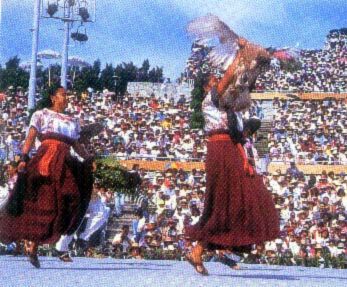 Overlooking the present city of Oaxaca is the hill now known as the Cerro del Fortín from the
location of Aztec garrisons there in the 15th century. This Cerro was a very popular place for
outings and came to be the traditional place for celebrating the Lunes del Cerro (Mondays on the
Hill) when the Guelaguetza began to focus on the celebrations held on the two Mondays following July
16.
Overlooking the present city of Oaxaca is the hill now known as the Cerro del Fortín from the
location of Aztec garrisons there in the 15th century. This Cerro was a very popular place for
outings and came to be the traditional place for celebrating the Lunes del Cerro (Mondays on the
Hill) when the Guelaguetza began to focus on the celebrations held on the two Mondays following July
16.
The festival endured through colonial and pre-Revolutionary times. Then in 1932, as part of the celebration of the 400th anniversary of the founding of the city of Oaxaca, groups from all the regions of the state paid homage to their capital with a great festival of dance, music and folkloric demonstrations.
In 1974, a special auditorium was opened to seat 11,400 spectators to accommodate the central act of the festival, the extraordinary dance and music performances.
Other diverse events and activities have been added to the festivities, such as food and arts festivals, concerts, art exhibitions and sporting events. Street fairs celebrate specific local goodies such as mescal, the amazing local candies, and perhaps the finest selection of fine arts and crafts assembled anywhere.
Mondays on the Hill this year are July 23 and 30. Tickets, available through the state tourist agency SEDETUR, cost 350 pesos.